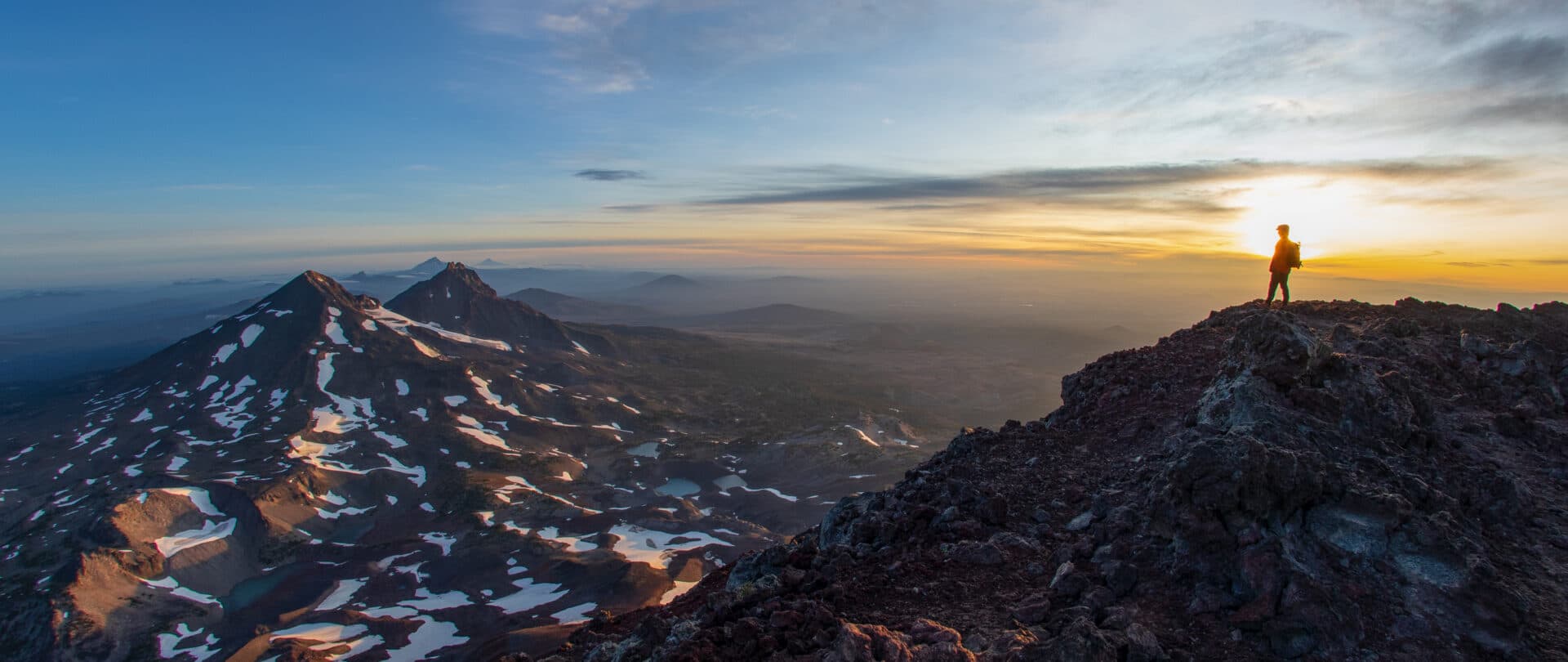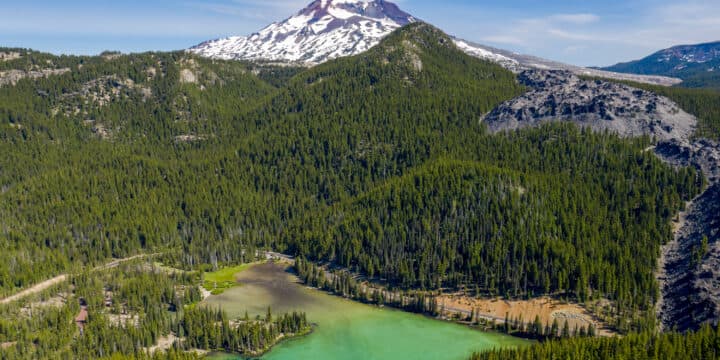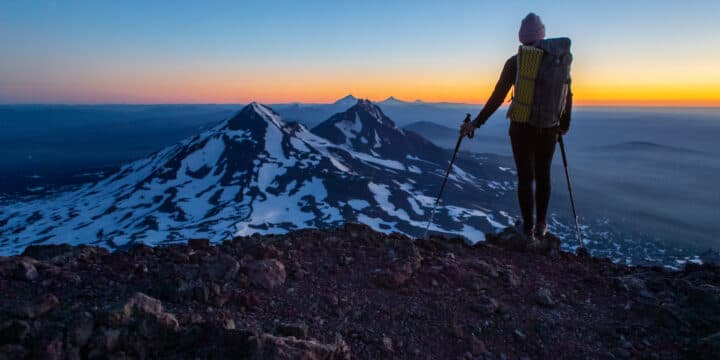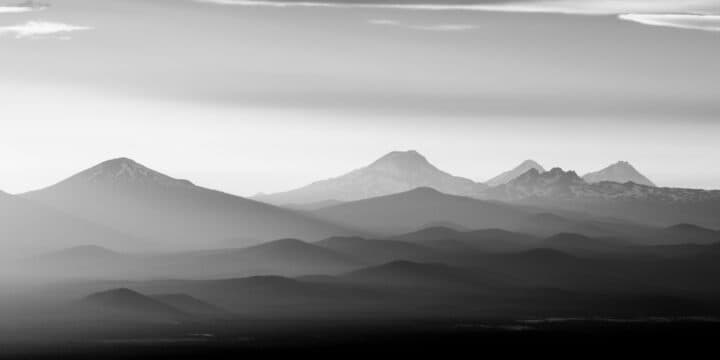
Discover Three Sisters Wilderness
Make permitting part of your plan as you explore these epic trails.
BY Meghan Robins
Look to the west to see Mt. Bachelor, Broken Top, and the Three Sisters Mountains crowning Bend’s skyline. These volcanic peaks are some of Oregon’s most popular destinations for outdoor recreation and for good reason.
Serving as landmarks for thousands of years, the Three Sisters rank third-, fourth- and fifth-highest mountains in Oregon, and they’re still growing. Since 2001, scientists have been monitoring uplift on South Sister’s western flank, noting approximately five inches of growth since the mid-1990s. According to the USGS, the cause may be an accumulation of magma or magmatic fluid (water and gas) four miles beneath the surface. Volcanologists are monitoring the Cascade Volcanic Arc daily, and residents and visitors can opt to receive updates about volcanic activity via email or text from the Volcano Notification Service (VNS). South Sister currently stands at 10,363-feet in elevation and last erupted 2000 years ago. Hikers can see evidence of that by the thick rhyolite lava flow on the middle apron of her southwest flank.
Indigenous nations populating the vast regions of the Pacific Northwest have various origin stories for how these mountains were formed. One story begins when the people living in the high desert asked Ocean to send his children, Clouds and Rain, to satiate their lands. When Clouds and Rain came, giving water to the earth, the people wanted more. Ocean, who had grown lonely without his children, traveled east only to realize the greed of people who never wished Cloud and Rain to leave. In anger, Ocean beseeched the Great Spirit to punish their greediness, and the Great Spirit abided, piling handfuls of earth into mountains and forever separating the high desert from the lush rainforests near the Ocean.
Another oral history passed down through generations and told by oral historian and spiritual leader Wilson Wewa of the Northern Paiute/Palouse nation (confluenceproject.org) explains that back when the mountains were people, there was a war. The mountains known today as Mount Adams in Washington and Mount Hood in Oregon were fighting over the most beautiful woman, Mount Saint Helens. Mount Adams and Mount Hood asked their relatives to come help them fight and people came from the north and south, following the trail toward the Columbia River. As relatives hurled spears and arrows tipped with fire, Coyote saw that their fighting was destroying the tops of mountains; they were destroying the world he created. He could not allow that to happen, so he turned them into mountains, who now make up the Cascade Range. Afterwards, the Plateau people gave these mountain names in their own languages to remember the mountains from when they were people.
Modern-day geologists claim that colliding plates, specifically the Pacific Ocean floor sliding beneath the North American plate, caused the original upheaval, and that the Three Sisters were formed at various times by different types of magma rising into volcanoes. However they came to be, the Three Sisters are enchanting.
In the mid-1800s, Euro-American colonizers from both the west and east sides of the Cascades traipsed across Oregon and recorded seeing towering, snow-covered peaks, sometimes reporting fire and smoke arising. Fittingly, some Christian missionaries in Salem are said to have named the mountains Mount “Faith,” Mount “Hope,” and Mount “Charity” in the 1840s. Today, most people know them as North Sister, Middle Sister, and South Sister respectively, with Broken Top just to the east and Mount Bachelor to the south.
Hikers of all skills can enjoy the Three Sisters Wilderness in a variety of ways. Once you secure your permits, pack a lunch, plenty of water, sunblock, bug repellent, and raingear (regardless of the weather report), and drive 30 miles from Bend up the Cascade Lakes Highway to Devils Lake Trailhead. From here, there are a variety of options for every kind of hiker.

Devils Lake Trail, 1.6 miles
One easy option great for kids and hikers of all ages is the 1.6-mile trail skirting the western edge of Devils Lake. Located southeast of the South Sister Volcano (“Charity”), the trail begins at the official Devils Lake Trailhead parking lot, passes a few walk-in campsites, and leads to myriad small alcoves along the lakeshore. The Devils Lake pictograph site can be found along a short, relatively unmarked gravel path on the northeastern side of the lake across the highway.
Moraine Lake, 5.6 miles
Those looking for a mid-range hike may enjoy the 5.6-mile out-and-back hike to Moraine Lake. Park at the Devils Lake Trailhead parking lot, walk across the highway to the trailhead, and begin your ascent through the forest. Despite this south-facing slope, dense conifers keep the trails cool, which means they may be icy depending on temperatures. After two miles of sustained uphill, emerge at a four-way crossing and the edge of Sandy Plain. If the clouds are willing to part, you will catch your first glimpse of the South Sister and Broken Top. Take the right fork and descend for half a mile to Moraine Lake, which is perfect for swimming and lunch.

South Sister, 11.6 miles
If summitting South Sister is your aim, get an early start. Six miles to the summit may sound manageable for more experienced hikers, but it’s a steep six miles, with loose-footing, dramatic weather patterns, and a frequently icy descent. Add another six miles back to the car and this hike is often a full day’s effort. When snow is present, winter hiking experience is recommended. Those who reach the top on a cloudless day are rewarded with breathtaking views of the Cascade Range, as well as the opportunity to dip your toes in Oregon’s highest lake: Teardrop Pool, a small, glacial blue crater lake sitting at the very top of the volcanic caldera.
No matter which adventure you choose, easy, medium, or hard, these three hikes each reveal the diverse beauty of the Cascade Range. Hikers should be aware of their surroundings and stay on marked trails to protect the fragile high desert alpine ecosystems. Those with stability issues may want to bring hiking poles; and dogs must be always kept on leash. During the wetter summer months, expect mosquitoes and mud, and always be prepared for inclement weather, regardless of the forecast. There are plenty of hikes throughout Central Oregon. These hikes beginning at Devils Lake Trailhead are just a few.

Take Note: Permits Are Required
For many years South Sister has averaged four hundred hikers per day in the peak season of August and September. The crumbly nature of the mountain and fragile ecosystem has seen plenty of side trails, side cuts, human waste, dog disturbance, and trash, which changes the serenity of this rewarding hike. In May 2021, the US Forest Service implemented a new permitting system for both overnight and day-use visitors within the Three Sisters Wilderness.
While new permitting rules are frustrating to many, reduce the chance for spontaneity, and create additional financial barriers for accessing nature, the Forest Service explains the system is in accordance with the Wilderness Act of 1964 and meant to protect landscapes for current and future visitors. Out of 79 trailheads within the Three Sisters, Mount Washington and Mount Jefferson wilderness areas, 19 trailheads require permits between June 15, 2022 and October 15, 2022. Permits are always required for overnight use. Visit fs.usda.gov for more information.
Before you plan any hike in the Central Cascades Wilderness Area, research what permitting rules apply at recreation.gov. Permits are typically $1, $6 or $10, depending on the details of your visit, and are released in two rolling windows: ten days and two days before the trip date. To avoid the $200+ fine, the permit-holder in your group must always carry a digital or paper copy with them. If you’re hiking outside the paid permitting window (June-October), you are still required to fill out the free permit form located at the trailhead.
In addition to hiking permits, drivers are required to display a Northwest Forest Recreation Pass in their car, which costs $5 per day or $30 annually, and can be used at Washington and Oregon recreation sites where day-use fees are required. These can be purchased online or at local outdoor shops.
To reduce the impact on the terrain and preserve the experience of solitude in nature, the US Forest Service is hoping that permitting rules help spread out visitors, despite the obvious drawbacks adding paid permits may further limit access to nature for low-income individuals and families. Whether you agree with these decisions or not, it is important to educate yourself about the rules, expectations, and permitting systems when visiting wilderness areas.
Then, after your relaxing or perhaps challenging hike, head back to Bend, refreshed and revitalized by nature’s beauty, and enjoy your choice of dozens of breweries, cider houses, kombucha bars, restaurants, and food trucks.
